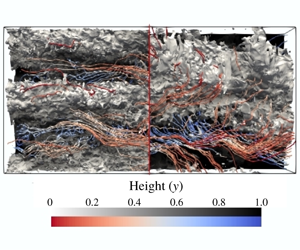Article contents
Large-scale structures in high-Reynolds-number rotating Waleffe flow
Published online by Cambridge University Press: 10 December 2019
Abstract

We perform direct numerical simulations of rotating turbulent Waleffe flow, the flow between two parallel plates with a sinusoidal streamwise shear driving force, to study the formation of large-scale structures and the mechanisms for momentum transport. We simulate different cyclonic and anticyclonic rotations in the range of dimensionless rotation numbers (inverse Rossby numbers)  $R_{\unicode[STIX]{x1D6FA}}\in [-0.16,2.21]$, and fix the Reynolds number to
$R_{\unicode[STIX]{x1D6FA}}\in [-0.16,2.21]$, and fix the Reynolds number to  $Re=3.16\times 10^{3}$, large enough such that the shear transport is almost entirely due to Reynolds stresses and viscous transport is negligible. We find an optimum rotation in the anticyclonic regime at
$Re=3.16\times 10^{3}$, large enough such that the shear transport is almost entirely due to Reynolds stresses and viscous transport is negligible. We find an optimum rotation in the anticyclonic regime at  $R_{\unicode[STIX]{x1D6FA}}=0.63$, where a given streamwise momentum transport in the wall-normal direction is achieved with minimum mean energy of the streamwise flow. We link this optimal transport to the strength of large-scale structures, as was done in plane Couette flow by Brauckmann & Eckhardt (J. Fluid Mech., vol. 815, 2017, pp. 149–168). Furthermore, we explore the large-scale structures and their behaviour under spanwise rotation, and find disorganized large structures at
$R_{\unicode[STIX]{x1D6FA}}=0.63$, where a given streamwise momentum transport in the wall-normal direction is achieved with minimum mean energy of the streamwise flow. We link this optimal transport to the strength of large-scale structures, as was done in plane Couette flow by Brauckmann & Eckhardt (J. Fluid Mech., vol. 815, 2017, pp. 149–168). Furthermore, we explore the large-scale structures and their behaviour under spanwise rotation, and find disorganized large structures at  $R_{\unicode[STIX]{x1D6FA}}=0$ but highly organized structures in the anticyclonic regime, similar to the rolls in rotating plane Couette and turbulent Taylor–Couette flow. We compare the large-scale structures of plane Couette flow and Waleffe flow, and observe that the streamwise vorticity is localized inside the cores of the rolls. We show that the rolls take energy from the mean flow at long time scales, and relate these structures to eigenvalues of the streamfunction.
$R_{\unicode[STIX]{x1D6FA}}=0$ but highly organized structures in the anticyclonic regime, similar to the rolls in rotating plane Couette and turbulent Taylor–Couette flow. We compare the large-scale structures of plane Couette flow and Waleffe flow, and observe that the streamwise vorticity is localized inside the cores of the rolls. We show that the rolls take energy from the mean flow at long time scales, and relate these structures to eigenvalues of the streamfunction.
JFM classification
- Type
- JFM Papers
- Information
- Copyright
- © 2019 Cambridge University Press
References
- 3
- Cited by


